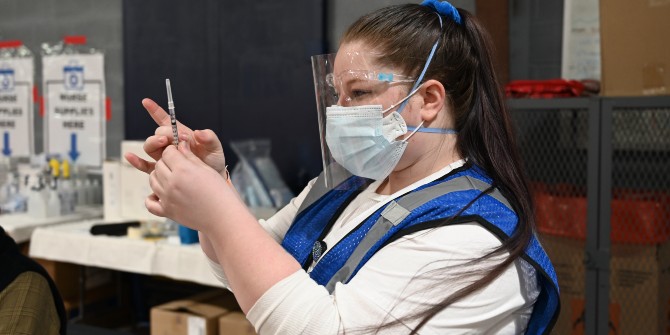Transparency and accountability are key in public procurement, but they deteriorated when governments scrambled to secure supplies during the pandemic, find Serena Cocciolo, Vincenzo di Maro (World Bank), and Sushmita Samaddar (University of Kansas). Those with emergency protocols and e-procurement systems already in place did better.
COVID has led to an enormous burden on public procurement services. Governments have responded in myriad ways – by rapidly adapting their procurement systems to cope with the emergency, by imposing export restrictions to deal with limitations in the supply of medical equipment, and by prioritising the procurement and transport of medical goods in regions that need it the most.
The typical trade-offs in public procurement between rules, discretion and accountability are intensified during emergencies, including the pandemic, since it is even more critical to procure essential goods and services in a timely manner.
In the early months of the pandemic, the World Bank conducted a survey of procurement experts to document the legal and administrative regulation for national emergency public procurement. The survey was implemented between April and August 2020, and it received 136 responses covering 103 countries. The survey was circulated among procurement specialists and experts inside and outside the World Bank. This post outlines three sets of results related to (i) transparency and accountability (T&A) standards, (ii) the role of systemic factors for rapid and effective emergency procurement.
i) T&A standards
Following the T&A principles for public procurement outlined by Transparency International and Open Contracting Data Standard, the survey investigated whether these principles apply to standard public procurement and for COVID-related procurement during the first months of the pandemic.
We found that T&A standards deteriorated for COVID procurement relative to standard procurement, especially whether public procurement information is easily accessible, readable, and downloadable, and the timeliness of making public procurement information publicly available. Following the T&A principles for public procurement outlined by Transparency International and Open Contracting Data Standard, the survey investigated whether these principles apply to standard public procurement and for COVID procurement during the first months of the pandemic.
The data show an overwhelming deterioration of T&A standards for emergency procurement, with the majority of the considered T&A principles required for standard procurement but not for COVID-related procurement. Public scrutiny from civil society and the media is critical when emergency procurement is conducted with expedited and simplified modalities and less ex ante oversight, as was often the case in COVID-related procurement, but the deterioration of transparency and accountability standards risks impeding this.
(ii) The role of systemic factors for rapid and effective emergency procurement
There is growing evidence on the role of institutions in explaining government responsiveness to the pandemic and associated mortality. We explore some systemic factors that can shape the readiness of public procurement systems and their ability to respond to emergencies in a timely and effective manner: e-procurement adoption; and the quality of institutions.
Countries with an existing e-procurement system had to introduce less drastic changes to adapt to the new circumstances resulting from the pandemic, and indeed they were able to adjust their public procurement functions more promptly. Lack of an e-procurement system was reported as a critical constraint for 59% of surveyed countries.
Several benefits are associated with e-procurement in general, and especially during emergencies. First, it is often associated with shorter processing and contracting times, which are critical dimensions during emergencies. Second, given the lockdowns and movement restrictions, an e-procurement system facilitated the ability of countries to continue their operations. Third, e-procurement systems can be more adaptable and resilient to rapidly changing circumstances. Fourth, e-procurement systems generate detailed public procurement data in machine-readable formats, enabling better planning and monitoring and facilitating auditing and ex-post reviews.
We find that countries countries with an existing e-procurement system had to introduce less drastic changes to adapt to the new circumstances resulting from the pandemic, and indeed they were able to adjust their public procurement functions more promptly. Lack of an e-procurement system was reported as a critical constraint for 59% of surveyed countries.

Overall, we found that countries with stronger institutions have greater flexibility in their public procurement framework and this flexibility shape the timeliness and quality of the procurement response to emergencies like the COVID pandemic.
First, institutions mattered for the timeliness of the first procurement response. The time between the tenth confirmed case in a country and the time of most changes in the legal and administrative framework for COVID procurement was shorter for countries with more democratic, transparent and accountable systems – as measured, for example, by media independence, opposition party autonomy, voice and accountability – but it was longer for countries with higher risks of diversion of public funds, public sector corruption and burden of government regulation.
Second, the deterioration of transparency and accountability standards was more contained in countries with stronger institutions. For example, the percentage of T&A standards that were waived for COVID procurement relative to the required ones for standard procurement is lower in countries with stronger regulatory quality, rule of law, media independence and opposition party autonomy.
Key points
• Countries with a well-developed legislative framework for emergency procurement were better prepared to face the pandemic, with less need to introduce changes, amendments or new legislation.
• Countries with an existing e-procurement system had to introduce less drastic changes to adapt to the new circumstances caused by the pandemic, and were able to adjust their public procurement functions more promptly.
• Lack of clarity on procurement needs and lack of coordination were important bottlenecks experienced during the first months of the pandemic by the majority of surveyed countries. These deficiencies created unnecessary competition and uncertainties for procuring entities trying to secure the necessary medical supplies and ensure their distribution.
• There are various systemic barriers impeding proper oversight. First, transparency and accountability standards deteriorated for COVID-related procurement with respect to pre-pandemic levels. Second, for most countries, COVID transactions can be identified only using key words in the tender description – a more explicit categorisation of COVID procurement would improve the transparency and usefulness of the available information. Third, publicly available procurement information is often incomplete, missing critical details on the contracting stage such as unitary prices or date of contract signature, and is even scarcer for the procurement modalities most common for emergency procurement, such as direct contracting. Given the public scrutiny of COVID procurement, there is now a window of opportunity for further advancements in transparency and accountability of public procurement.
This post represents the views of the authors and not those of the COVID-19 blog, nor LSE. It is an edited extract from Cocciolo, S., Di Maro, V., Samaddar, S., Public procurement at the onset of the COVID-19 pandemic, in ed. Bandiera, O., Bosio, E., Spagnolo, G., Procurement in Focus: Rules, Discretion and Emergencies, CEPR Press, 2021, available as an ebook. It also appears in Opportunities and Challenges for Public Procurement in the First Months of the COVID-19 Pandemic: Results from an Experts Survey, World Bank, 2021.





